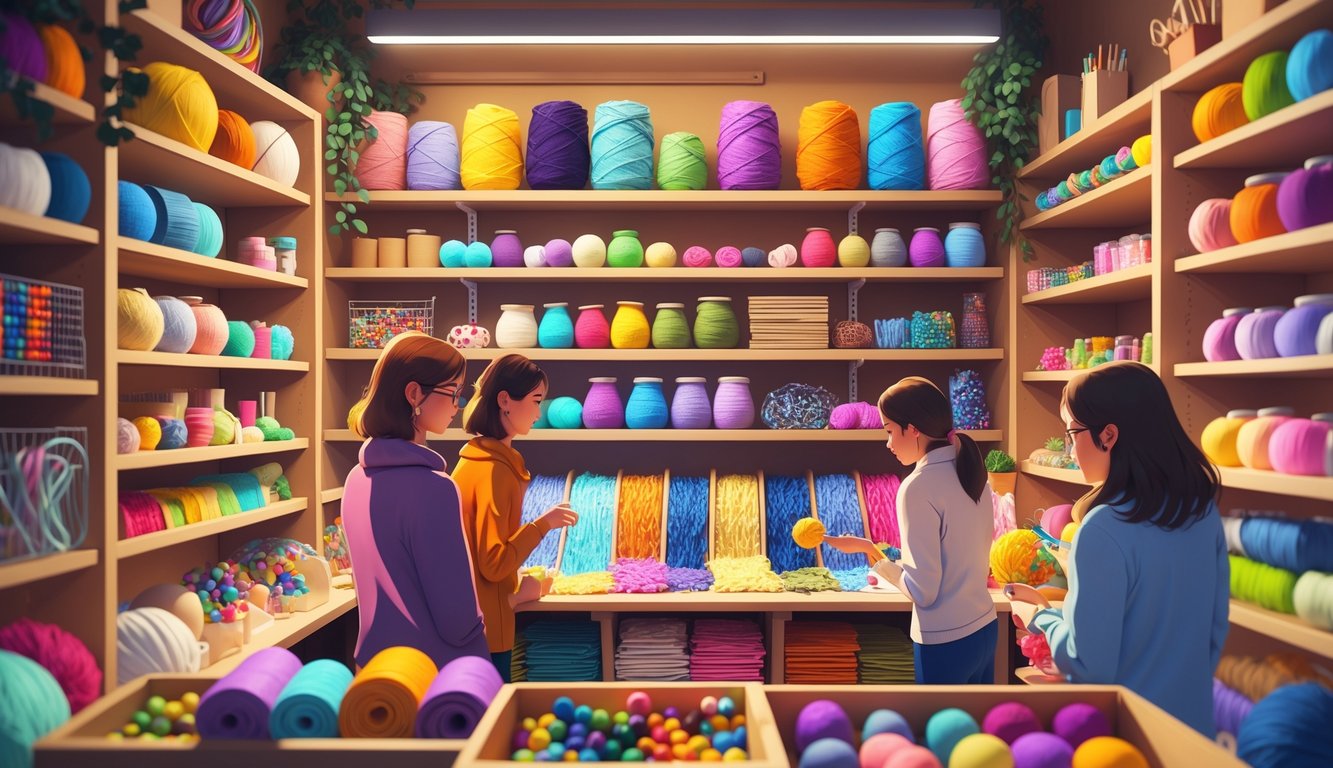
The Growing Influence of Online Craft Supply Exchanges
Honestly, I can’t keep up. There’s always some vintage ribbon on Etsy, half-used paints in a Facebook group, and it’s gone before I decide if I need it. Prices are all over the place, supplies disappear for months or flood my feed for a week. Retailers? I’m sure they’re pretending not to notice that swaps are eating into their sales.
The Role of Etsy and Online Groups
Etsy search is a nightmare—yesterday I found discontinued Prismacolor markers from “StencilCrafter264” for half what Michaels wanted last year. There’s no boss here—Reddit, Discord, and especially those private Facebook groups move swaps at lightning speed.
Susan from my embroidery Zoom group dumps extra wool on Etsy’s “destash” section, but I’ve seen her swap on r/crafts for washi tape. Blink and that rare green dye lot is gone. Retailers can’t stock these micro-trends, and big shops just ignore it. Honestly, I trust real reviews and user pics—almost got scammed with fake Mod Podge, but the sketchy label tipped me off.
Benefits and Challenges of Digital Swaps
Trading yarn or paint online? Feels like speed dating with bubble mailers. Shipping costs get ridiculous—a two-yard linen swap can get expensive if it’s overseas, but finding vintage Coats thread is worth it. Sometimes you get mismatched dye lots or someone’s cat hair. And if you swap outside Etsy’s payment system, you’re on your own.
PYMNTS.com says there’s a “noticeable shift” to digital-first buying for non-essential craft stuff. Sounds right—my receipts agree. Digital swaps stretch the budget, but scams, lost mail, or peanut butter-scented felt (don’t ask) make it messy. Meanwhile, retailers just hope newbies stick to buying full-priced kits, probably not realizing a single Reddit thread can wipe out their glue gun aisle overnight.
Retailer Reactions and Adaptations to Material Swaps
Alright, so here’s my take: retailers aren’t just sitting around, twiddling their thumbs, hoping supply chain chaos magically sorts itself out. They’re scrambling—sometimes it’s impressive, sometimes it’s a mess. I mean, you ever see a store suddenly “discover” a new artisanal yarn blend the same week all the usual brands vanish? That’s not a coincidence. They’re swapping stuff out, making up new labels, and basically praying nobody notices their “exclusive” is just whatever was left in the warehouse. Sometimes, honestly, I think they get more creative when things go wrong.
Understanding the Retail Perspective
Forget all that corporate “innovation” fluff. I’ve talked to people in the trenches (Jay, you know who you are, still grumbling about the cotton shortage) and it’s just triage, all day. The second there’s even a rumor that, say, acrylic is delayed, everyone’s on Slack trying to find a substitute. But here’s the kicker: they’re obsessed with margins. Nobody wants to admit they swapped out the fancy yarn for something cheaper, but if you’ve got any sense of touch, you’ll know.
Saw this survey—2024, big supply chain thing—apparently 63% of retail execs are losing sleep over unpredictable demand, even more than tariffs or whatever new rule the government just dropped. So, what do they do? They rotate stock, slap “limited edition” on whatever they have too much of, and hope shoppers don’t ask questions. An ex-buyer friend straight-up told me: “We swap in the cheap stuff and cross our fingers.” The packaging? All those “New! Artisanal Blends!”—yeah, that’s mostly damage control, not trendsetting. I keep seeing these “mystery fiber” bins in stores lately, too. Anyone actually believe those are just happy accidents? Please.
How Some Retailers Are Embracing Community
“Community engagement.” I laugh every time I hear that phrase. Sure, retailers do Instagram Q&As and let people vote on “color of the month,” but mostly they’re mining for free tips before the forums spill the secrets. I’ve joined “community craft nights” that felt more like undercover market research—staff jotting down every hack we mention, probably for their next product guide.
There’s data floating around (Liz Martin, Stitch Retail—she’s everywhere now) saying user-generated hacks boost sales by 18% when stores push them. But, shocker, those hacks usually come bundled with whatever they need to move. And let’s be real, online forums always figure out the swaps before the stores do. The moment a DIY vlogger hypes a new candle ingredient, suddenly that off-brand paraffin disappears from shelves. Retailers act like it’s all “community synergy,” but half the time it’s just panic mode with a smile. Crafters aren’t just customers—they’re the R&D team, and they’re not even getting paid for it. Most of the real action happens in group chats anyway.
Practical Tips for Successful Craft Supply Swaps
Nobody warned me about the mountain of leftover fake fur and the endless parade of dried-out washi tape. Crafters don’t want a theory lesson—they want working glue guns, someone to keep the group chat from exploding, and, for the love of all things sparkly, a rule that stops Carol from dumping three tables of half-used paint. I’ve watched both small groups and giant online swaps fall apart over the basics. Set rules, or chaos reigns.
Organizing Local Swap Events
Picture this: it’s Thursday night, I’m dragging folding tables into a rec room because two people brought “vintage” yarn that smells like mothballs. No RSVP? People just show up with suitcases. What actually works? Item limits (5-10, don’t argue), labeled boxes for every supply type (beads, fabric, you name it), and a sign-in sheet so you know who brought what.
You forget snacks, people get cranky. You forget to check who’s actually in the group, someone’s cousin shows up with a trunk of broken crayons. Community centers and libraries are great, but if you don’t plan cleanup, you’ll be scraping glitter out of the floor at midnight. Someone once told me: expect 20% no-shows, but honestly, I’ve seen it swing way higher if it rains.
Ensuring Fairness and Fun
It’s brutal if someone leaves empty-handed. Swap tickets work—bring five things, take five things. Random draws? Sounds cute until Susan wants the pom-pom maker and ends up with scented candles. There’s always someone who tries to sneak extra junk onto the “free” table. Tried shaming them once—not worth it. A “final claim” round helps, so nobody gets stuck with pipe cleaners they’ll never use. That Craft Industry Alliance survey (2023) said over 80% of crafters think clear rules matter. They’re right. But rules are pointless if you don’t actually enforce them—people remember, and so does the group chat. Side contests, like “best upcycled supply”? Fun in theory, usually devolves into arguing over who gets the glue gun. Every. Time.



